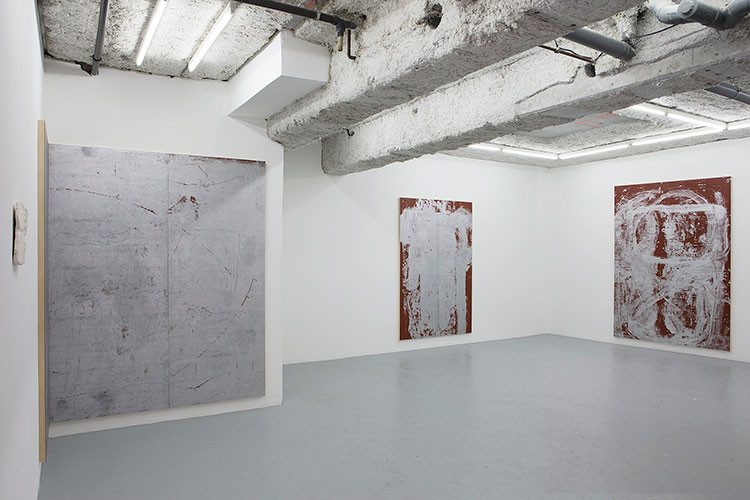Alexander May
11 Sep - 11 Oct 2014
ALEXANDER MAY
Auditory Posture O
11 September – 11 October 2014
‘’War happens when language fails’’ wrote Margaret Atwood—the despair which haunts men's history states that language often failed in fact. War incited art imbued in displacement, vexation and anger; art which hailed indeed not muteness, but the advent of uncodifiable codes. In Alexander May's second solo exhibition at the gallery, titled "Auditory Posture O", the art subtends a multiplicity of codes. But their advent in the shape of the artworks doesn't occur into a babylonesque cacophony, and into an uncodifiability which is rather peaceful: the gestures hold a primordial stasis, the pictures a profound humanity—Margaret Atwood could state that here language have failed without inciting any war.
The codes don't hide the meanings. Alphabets as notations, behavioral patterns as systems of symbols—no term or sound, no gesture or picture is lost in translation; since the terms and the sounds, the gestures and the pictures hold no actual meaning to lose. The artworks entail a semantical vacuity that leads to the nullification of any codifying plan; instead they engage in the exercise of pure syntax. Hence, the medium is dead, the message is dead. Don't ask. Just understand your own body within the room as itself a code: a conductor. Listen and pose. And enjoy this being in a flux. Talk and see, if you like. Mouths lie on several of the artist's paintings; along with eyes, alphabets, and unintelligible typography. Indeed the signs don't claim allegorical nature; they are rather indexical presences, as if the artist can actually talk and see through his making hand. Paintings unfold gestures that trace back to pictures, and pictures that vanish into gestures. They are neither abstract nor figurative, neither gestural nor compositional—layers of artistic languages overlap and deny each other, in the same vein the artist's desire for communication is trapped into the materiality of the artwork itself.
The exhibition itself is a trap. The sounds scattered within the room are the unsteady translations of these words. Very few had entered the artist's cosmos in those few hours when he played his glass organ: he fucked the C-D-E-F-G-A-B notation, and still searched for harmony—so miserably. The playing in the presence of the other was as the search for the correct statement of thought. The question has always been if you and I understand each other... At least we try, fo sho we try. Translate the organ into a laptop keyboard, so I can talk to you through sounds. Oh, don't be afraid of them, they come from the past, but are not ghostly voices. They come from the very first time we meet, and come to us through our shared experiences... Because this we share, not language, not symbols... Life, I guess... They are called green noises. And what plays here is a green organ. Oh, I tell you, there is green as well in this exhibition.
Michele d’Aurizio
Auditory Posture O
11 September – 11 October 2014
‘’War happens when language fails’’ wrote Margaret Atwood—the despair which haunts men's history states that language often failed in fact. War incited art imbued in displacement, vexation and anger; art which hailed indeed not muteness, but the advent of uncodifiable codes. In Alexander May's second solo exhibition at the gallery, titled "Auditory Posture O", the art subtends a multiplicity of codes. But their advent in the shape of the artworks doesn't occur into a babylonesque cacophony, and into an uncodifiability which is rather peaceful: the gestures hold a primordial stasis, the pictures a profound humanity—Margaret Atwood could state that here language have failed without inciting any war.
The codes don't hide the meanings. Alphabets as notations, behavioral patterns as systems of symbols—no term or sound, no gesture or picture is lost in translation; since the terms and the sounds, the gestures and the pictures hold no actual meaning to lose. The artworks entail a semantical vacuity that leads to the nullification of any codifying plan; instead they engage in the exercise of pure syntax. Hence, the medium is dead, the message is dead. Don't ask. Just understand your own body within the room as itself a code: a conductor. Listen and pose. And enjoy this being in a flux. Talk and see, if you like. Mouths lie on several of the artist's paintings; along with eyes, alphabets, and unintelligible typography. Indeed the signs don't claim allegorical nature; they are rather indexical presences, as if the artist can actually talk and see through his making hand. Paintings unfold gestures that trace back to pictures, and pictures that vanish into gestures. They are neither abstract nor figurative, neither gestural nor compositional—layers of artistic languages overlap and deny each other, in the same vein the artist's desire for communication is trapped into the materiality of the artwork itself.
The exhibition itself is a trap. The sounds scattered within the room are the unsteady translations of these words. Very few had entered the artist's cosmos in those few hours when he played his glass organ: he fucked the C-D-E-F-G-A-B notation, and still searched for harmony—so miserably. The playing in the presence of the other was as the search for the correct statement of thought. The question has always been if you and I understand each other... At least we try, fo sho we try. Translate the organ into a laptop keyboard, so I can talk to you through sounds. Oh, don't be afraid of them, they come from the past, but are not ghostly voices. They come from the very first time we meet, and come to us through our shared experiences... Because this we share, not language, not symbols... Life, I guess... They are called green noises. And what plays here is a green organ. Oh, I tell you, there is green as well in this exhibition.
Michele d’Aurizio

